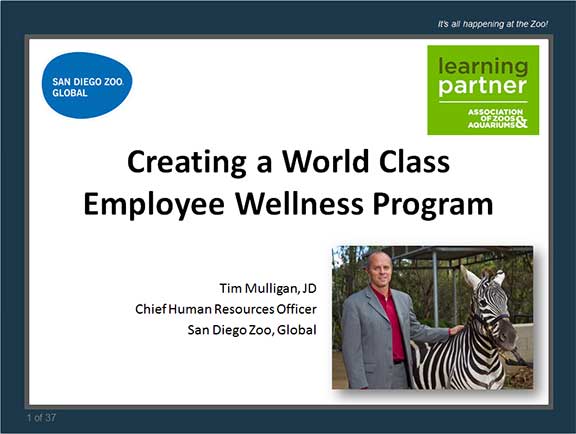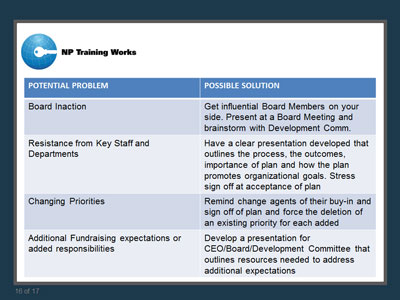 |
World Class Wellness |
1.00 |
In 2011, San Diego Zoo Global rolled out the "Roar Longer" program, a comprehensive workplace wellness program. For two years, this program has successfully taken engagement, productivity, and health minded thinking to another level. In this webinar, Tim Mulligan, Chief Human Resources Officer for San Diego Zoo Global, will teach participants the tricks of the trade in building a results-oriented wellness program. |
 |
Worms, Germs and You (Introduction to Zoonotic Disease) UPDATED |
0.50 |
Worms, Germs, and You is an introductory course to the basic principles of zoonotic disease education and disease prevention. You will learn about some basic disease biology and terminology, as well as a variety of prevention techniques to be applied at work and at home. Finally, a few zoonotic disease examples will reinforce lessons learned and help you apply some of this information to real disease scenarios. When remembered and practiced, the material in Worms, Germs, and You will greatly decrease your chances of contracting a zoonotic disease.
|
 |
Writing Skills |
0.50 |
In this course, you will learn how to develop your writing abilities by pursuing inspiration, practicing writing business letters and emails, differentiating between active and passive voice, and more. |
 |
Writing the Annual Development Plan |
1.00 |
The key to success in any Development department is having a solid plan. Development Planning helps you stay on task and stick to your goals when everyone is pulling you in multiple directions. Planning also gives you the option to be flexible when necessary. In this Webinar you will learn the key elements of a successful Annual Development Plan and have a toolkit for your own planning. This Webinar will help you: understand the development function and how it interacts with, and relates to the functions of other departments; create a development philosophy that guides your overall vision for success; set development goals; create action plans for each area of responsibility within the development function; create donor contact plans; understand the various development categories and identify the categories you are responsible for in your organization; and, identify material needs for your development office, download examples of materials and edit them for your own use.
|
 |
Young Worker Safety Training |
0.75 |
This course covers federal laws regarding working minors as well as common workplace hazards. |
 |
Youth Development Trends: Focus on Older Youth |
2.00 |
The Center for Early Adolescence at the University of North Carolina and the Search Institute have found that early adolescence is a time of rapid change in youth development and developmental needs. For many children, the characteristic needs of early adolescence begin to emerge as early as age nine, when children are still in elementary school and attending traditional OST programs. OST professionals who understand these emerging needs are better equipped to create successful program experiences with older children in their programs.
The number of quality OST programs for children between five and twelve is steadily growing across the country. At the same time, there is increasing public interest in establishing programs that can also address and support the out-of-school needs of children over age twelve. For many years, communities tried to meet the needs of older youth by a problem-solving approach that focused on helping youth by fixing what was wrong. New trends in youth development take a more positive approach and are focused on working with youth to create positive outcomes.
OST professionals who are knowledgeable about adolescent development and developmental needs and are knowledgeable about youth development research and trends can play important roles in helping their communities design and develop the next level of program services for children over the age of twelve. By learning about ways to support the developmental needs of older youth, OST professionals can join with others to create strategies and programs for continuing to build on the positive experiences younger children have in their OST programs. |
 |
Youth Development Trends: Focus on Older Youth (Collection) |
2.00 |
The Center for Early Adolescence at the University of North Carolina and the Search Institute have found that early adolescence is a time of rapid change in youth development and developmental needs. For many children, the characteristic needs of early adolescence begin to emerge as early as age nine, when children are still in elementary school and attending traditional OST programs. OST professionals who understand these emerging needs are better equipped to create successful program experiences with older children in their programs.
The number of quality OST programs for children between five and twelve is steadily growing across the country. At the same time, there is increasing public interest in establishing programs that can also address and support the out-of-school needs of children over age twelve. For many years, communities tried to meet the needs of older youth by a problem-solving approach that focused on helping youth by fixing what was wrong. New trends in youth development take a more positive approach and are focused on working with youth to create positive outcomes.
OST professionals who are knowledgeable about adolescent development and developmental needs and are knowledgeable about youth development research and trends can play important roles in helping their communities design and develop the next level of program services for children over the age of twelve. By learning about ways to support the developmental needs of older youth, OST professionals can join with others to create strategies and programs for continuing to build on the positive experiences younger children have in their OST programs. |
 |
Youth Development Trends: Focus on Older Youth: Developmental Needs |
1.00 |
The Center for Early Adolescence at the University of North Carolina and the Search Institute have found that early adolescence is a time of rapid change in youth development and developmental needs. For many children, the characteristic needs of early adolescence begin to emerge as early as age nine, when children are still in elementary school and attending traditional school-age care programs. School-age care professionals who understand these emerging needs are better equipped to create successful program experiences with older children in their programs. In this course, we will explore the developmental needs of older youth. |
 |
Youth Development Trends: Focus on Older Youth: Programming Approaches |
1.00 |
The Center for Early Adolescence at the University of North Carolina and the Search Institute have found that early adolescence is a time of rapid change in youth development and developmental needs. For many children, the characteristic needs of early adolescence begin to emerge as early as age nine, when children are still in elementary school and attending traditional school-age care programs. School-age care professionals who understand these emerging needs are better equipped to create successful program experiences with older children in their programs. In this course, we will examine programming approaches that address the needs of older youth. |
 |
Zoo Exhibit Design: Past, Present and Future |
1.00 |
This presentation will give a brief history of zoos and animal exhibit design, discuss the theories behind modern exhibitry and the process for implementing them, and will end with a look at where exhibit design is headed in the future. |











